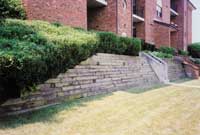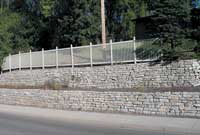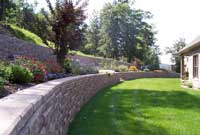Out with the Old Wood - In With the New Block
Segmental Retaining Wall Products That Last A Lifetime
While surprises are often good, sometimes they can present a serious challenge. Take the case of a Minnetonka, MN couple who decided to replace a degrading timber retaining wall in their pool and patio area. When the decayed and bulging retaining wall was removed, they discovered something unusual. Behind the first wall was yet another wall with decaying landscape timbers! A previous owner had simply layered a new timber wall over the original timber wall which had degraded.
In their search for a durable material that would not decay over time, the homeowners discovered the AB Europa Collection from Allan Block. The Autumn Blend color, manufactured by local producer Amcon Block, was a perfect accent to their wooded backyard setting.
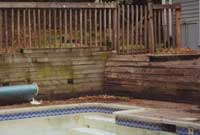
"This was another typical decaying wood retaining wall... pitching forward, bad drainage, rotting and looking scary" - Ed Johnson, Hunter Landscapes

Hunter Landscapes of Edina, MN produced the final design and handled the installation of the Allan Block retaining wall. Hunter Landscapes' owner Ed Johnson summed up the project, "This was another typical decaying wood retaining wall - pitching forward, bad drainage, rotting and looking scary. The funny thing was that when we did the tear-out, we discovered another wood wall behind it. You would think the homeowner who installed the second timber wall would have realized that wood is only a temporary solution - two wrongs don't make a right."
Hunter Landscapes took advantage of Allan Block's Timber Replacement Program, a partnership with Waste Management Company to safely remove more than 300 square feet (28 m²) of treated timbers. Waste Management provided the owners with a letter certifying that the toxic wood timbers would be properly disposed of following EPA guidelines.
Johnson has nearly 15 years experience working with Allan Block products. "I used the Original Allan Block back in 1991 and have had numerous AB projects since then," stated Johnson. "Two seasons ago, my foreman and I attended an AB Contractor Certification Program. I picked up a few more tricks of the trade and got AB Certified. Installing the AB Abbey Blend patterned walls takes a little more time when you first work with it, but it's a nice looking product and the homeowners love it."
The current homeowners now look across their pool at their new Allan Block walls and know that they will retain their beauty and value - never needing replacement again.
Segmental Retaining Walls Are King Of The Hill

Many people think of mortarless stackable blocks as a modern invention, but they existed thousands of years ago. We need only look at the Great Pyramids in Egypt to see the versatility and durability of mortarless stone construction. Recent advances in construction materials and techniques have taken dry stack construction to a new level.
Just 20 years ago, builders and homeowners needing retaining walls had a limited choice of materials and techniques: treated wood, cast-in-place concrete, concrete masonry block or natural stone. Each has it own limitations as to installation, design and cost.
For example, while treated wood may have been inexpensive to procure and abundantly available, they begin to rot and decay shortly after installation and have been declared an environmental hazard by the Environmental Protection Agency.
Although natural stone is a durable and beautiful material, high costs and installation difficulties limit its use in the average landscape project.
Mortared concrete block and cast-in-place concrete walls involve highly paid, skilled labor and take more time to install and they will need stone or brick facings if aesthetics are important.
In 1986, Allan Block introduced its first Segmental Retaining Wall block (SRW). The "Original" Allan Block featured an innovative concrete block design that allowed retaining walls to be built quickly and easily without footings, mortar joints or pins. The retaining wall market hasn't been the same since.
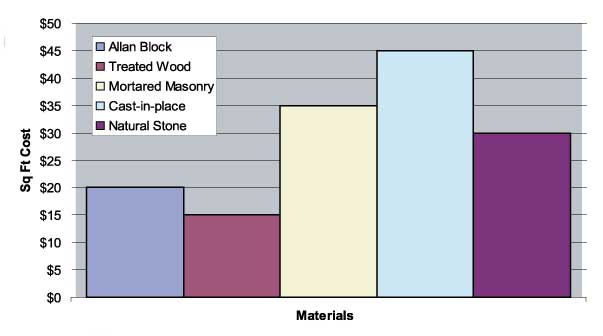
Each of the different retaining wall materials has unique attributes that make it suitable for different wall projects and job sites. Before choosing a wall material, architects and contractors should consider the differences and advantages of each.
Factors to evaluate include the quality and durability of the material, necessary labor skills, installation ease and total project costs. The table on the below page highlights the key differences between the materials.
Total Installed Cost Per Square Foot
| Allan Block SRW | Treated Wood | Mortared Concrete Block | Cast-In-Place Concrete | Natural Stone | |
| Product Durability | ✓ | No | ✓ | ✓ | ✓ |
| Unlimited Design Options |
✓ | No | No | No | ✓ |
| Easy to Install | ✓ | ✓ | No | No | No |
| No Footing Required Below Frost Depth |
✓ | ✓ | Footing Required | Footing Required | ✓ |
| Installed By Unskilled Labor |
✓ | ✓ | No | No | ✓ |
| Wall Flexibility | ✓ | No | No | No | ✓ |
| Low Cost Materials | ✓ | ✓ | No | No | No |
| Applications | Residential Commercial |
Residential | Residential Commercial |
Commercial | Residential |
| Contractor Profitability | ↑ | ↓ | ↓ | ↓ | ↓ |
| Product Growth Potential | ↑ | ↓ | ↓ | Stable | Stable |
| Average Costs/SQ Ft. | $15 - $25 | $10 - $20 | $30 - $40 | $40 - $50 | $20 - $40 |
These charts show typical total costs for each type of retaining wall and their differences. Costs include not only the material, but the labor and installation as well. Soil excavation, common for mortared masonry and cast-in-place concrete, along with skilled labor, greatly increases the costs and complexity for using those materials.
Each of the retaining wall products has its place. When considering which product to use on your next job, look at the total costs and both immediate and long-term benefits. When you add it all up, Allan Block delivers the best overall value, selection, style, performance and cost.
Excerpt from Landscape Newsletter Issue #4

